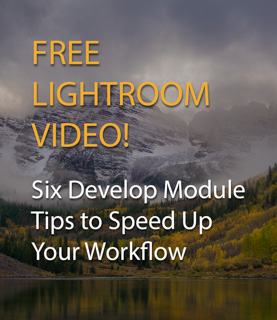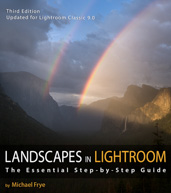In the Moment:
Michael Frye's Landscape Photography Blog
by Michael Frye | Dec 4, 2012 | Yosemite Photo Conditions
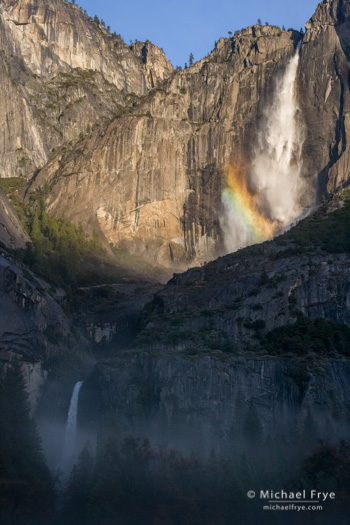
Upper and lower Yosemite Falls with a rainbow
For 20 years my wife Claudia and I lived in Yosemite Village, right underneath Yosemite Falls. In spring, when full from snowmelt, the roar from the fifth-highest waterfall in the world was the background music to our life in Yosemite Valley.
In late summer and autumn Yosemite Falls diminishes, sometimes dwindling to a wet stain on the cliff below Yosemite Point. This year it dried up even earlier than usual, a casualty of last winter’s meager snowfall.
But last week a series of warm, wet storms soaked northern California. Yosemite Valley received almost seven inches of rain between Wednesday morning and Sunday evening. Yesterday, after the storms finally departed, I drove up to Yosemite Valley, stepped out of my car at Swinging Bridge, and heard that familiar sound: the rumble of Yosemite Falls. It’s back, and so are all the other waterfalls in the Valley. It seemed more like May than December, except that the grasses were brown, and the trees were mostly bare with lingering splashes of fall color.
One of Yosemite’s photographic ironies is that in spring, when the thunder of Yosemite Falls rattles windows in Yosemite Village, the sun only hits the fall during the middle of the day. In winter the sun strikes the upper fall with beautiful, warm, low-angle light shortly after sunrise. You can even see rainbows from the right spot. But of course the flow is usually low during these colder months — except, that is, when heavy, warm rains fall, like they did last week.
(more…)
by Michael Frye | Nov 21, 2012 | Announcements
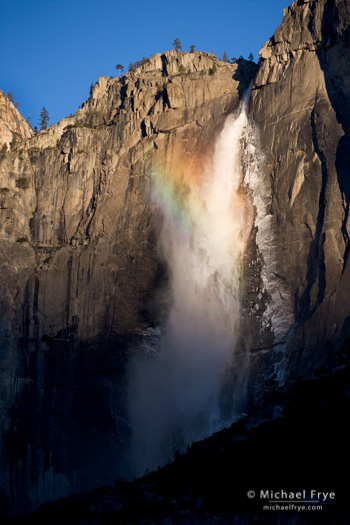
Upper Yosemite Fall and rainbow, December 2005
We all have a lot to be thankful for. Today, I’m especially grateful for all of you. I really appreciate your readership, comments, and support. Your participation, insights, ideas, and passion for photography make writing this blog fun!
And… I’m thankful for water. A few small storms have recently revived Yosemite Falls after a long absence, and it’s good to have it back. Last winter was exceptionally dry, so I’m hoping that the storms continue, and we have lots of that precious resource, water, throughout this winter and spring.
I hope you all have a wonderful holiday, with good food and lots of love in the company of family and friends. Don’t eat too much. Okay, it’s Thanksgiving — eat as much as you want!
— Michael Frye
by Michael Frye | Nov 21, 2012 | Announcements, Reviews
 Even if you know a program well it helps to have a comprehensive guide, a book that covers everything from A-Z, so you can look up a keyboard shortcut, remember how to do that thing that you only do once a year, or learn some new tricks.
Even if you know a program well it helps to have a comprehensive guide, a book that covers everything from A-Z, so you can look up a keyboard shortcut, remember how to do that thing that you only do once a year, or learn some new tricks.
My favorite Lightroom bible has been Martin Evening’s The Adobe Photoshop Lightroom 4 Book. I still think that’s a great resource, but I might have a new favorite: Piet Van den Eynde’s new ebook called Lightroom 4 Unmasked.
This is a truly comprehensive guide to Lightroom 4, from setting up and importing, to organizing in the Library Module, processing images, mapping them, exporting them or publishing them to Flickr or Facebook, and printing.
If you’re new to Lightroom there’s a lot of great information here to help you get started. For example, the Lightroom Do’s and Don’ts (page 20) offers some invaluable advice to help you make the most of the program and avoid some common pitfalls.
Even if you know Lightroom well you’ll undoubtedly discover some new tips. One that I’m anxious to try is on page 238 — using Lightroom’s Publish Services to automatically put images on my iPhone and iPad. Cool — I didn’t know you could do that.
This is another ebook by Craft & Vision, the publisher of my two previous ebooks. But this one is different. Craft & Vision is calling this a “big book,” and it is that: a full 312 spreads. Because this is roughly four times the size of their typical ebooks, the price for Lightroom 4 Unmasked is higher than normal — $20. But until midnight on Tuesday, November 27th you can get it for only $15. Just use the code LR4FIVE on checkout.
(more…)
by Michael Frye | Nov 15, 2012 | Yosemite Photo Conditions
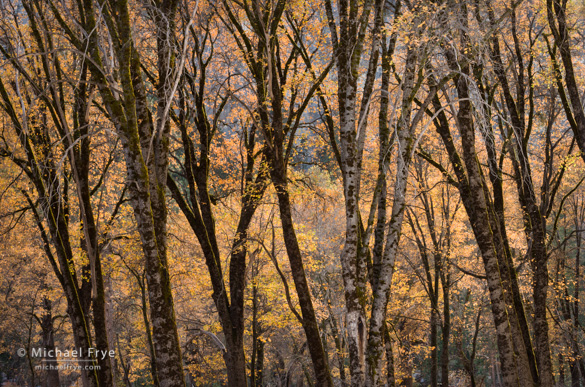
Oaks in El Capitan Meadow yesterday
During last weekend’s snowstorm I saw maples and cottonwoods dropping leaves in bunches, and wondered how much fall color would survive. But while teaching a private workshop yesterday I saw that there was still some good color in Yosemite Valley. The oaks are in great shape, as you can see from this photograph in El Capitan Meadow that I grabbed yesterday afternoon. Most of the dogwoods also kept their leaves and their color. But the maples are now mostly bare, and some of the cottonwood leaves changed from vibrant yellow to rusty brown. Strangely though, some dogwoods, cottonwoods, and oaks are still partially green. We even saw some dark green cottonwoods near Swinging Bridge—an odd sight for November 14th.
While the peak color has passed, those green leaves suggest that we might still see some good fall foliage in the valley for another week or two. It’s been a strange, late, yet beautiful autumn in Yosemite.
— Michael Frye
Related Posts: Early November Magic in Yosemite; A Beautiful Autumn in Yosemite; Autumn Progress in Yosemite
by Michael Frye | Nov 13, 2012 | Yosemite Photo Conditions
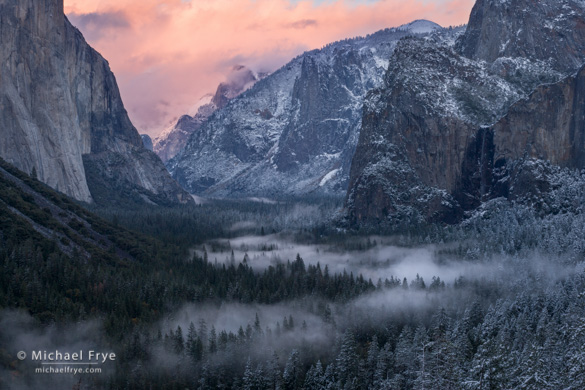
Sunset from Tunnel View, Saturday, 4:48 p.m.
My friend Jeff Grandy talks about “edges of seasons” — how the transitions between seasons can create great opportunities for photographs. Early November in Yosemite Valley is one of those transition periods, as fall blends into winter. Autumn color lingers in the oaks and cottonwoods, the sun tracks lower and creates interesting lighting angles, and sometimes the first winter storms generate clouds, mist, or even snow. It might be my favorite time of year in Yosemite.
This year the autumn color was late, but exceptional, with all four major species of deciduous trees turning at the same time. That in itself would be great, but then, at the peak of fall color, a storm brought snow last Thursday night, Friday, and Saturday. Friday was gorgeous, but Saturday was even better: a snow squall ended just before sunrise, the sun broke through shortly afterward, and soon we had a classic Yosemite clearing storm combined with snow and fall color.
(more…)
by Michael Frye | Nov 8, 2012 | Yosemite Photo Conditions

El Capitan, California black oaks, and the Merced River, 2007
Since my post last week the fall color has multiplied, and it’s beautiful in Yosemite Valley right now. There are still some green leaves, so the color overall is just short of peak, but it’s already one of the best autumn displays I’ve seen in the park, with the black oaks, big-leaf maples, dogwoods, and cottonwoods all turning simultaneously. The oaks seem to be particularly nice this year. The accompanying photograph was made in 2007, but the oaks look just like that now.
Forecasts call for colder and wetter weather to arrive today and tomorrow. Precipitation is expected to be light, but temperatures will drop, and we may get a dusting of snow on those yellow and gold leaves Friday or Saturday. If the leaves survive the cold and possible wind we should have great color through the weekend and into next week.
—Michael Frye
Related Post: Autumn Progress in Yosemite
Michael Frye is a professional photographer specializing in landscapes and nature. He is the author and photographer of The Photographer’s Guide to Yosemite, Yosemite Meditations, and Digital Landscape Photography: In the Footsteps of Ansel Adams and the Great Masters, plus the eBooks Light & Land: Landscapes in the Digital Darkroom, and Exposure for Outdoor Photography. He has written numerous magazine articles on the art and technique of photography, and his images have been published in over thirty countries around the world. Michael has lived either in or near Yosemite National Park since 1983, currently residing just outside the park in Mariposa, California.
by Michael Frye | Nov 1, 2012 | Yosemite Photo Conditions
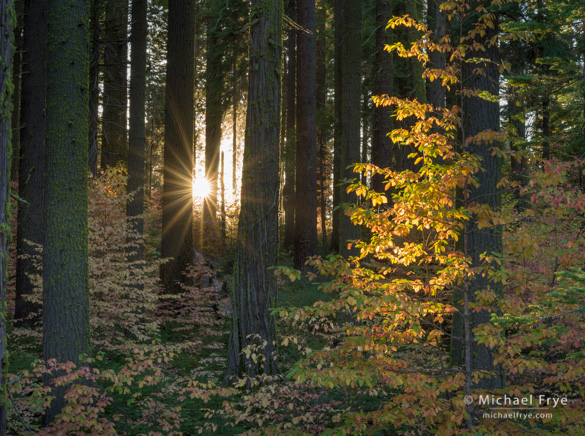
Dogwoods at sunset along Highway 120, Sunday evening
I’m teaching my Digital Landscape Photography workshop right now, but wanted to let you all know that the autumn color is looking better every day in Yosemite Valley. It might be a good year—though a late one—with the oaks, maples, dogwoods, and cottonwoods all turning at about the same. The color isn’t at peak yet, but should look very good overall by this weekend, and even better the following week.
I made this image outside of Yosemite Valley along Highway 120 a few days ago. The dogwoods at this higher elevation are beautiful right now. I haven’t been to the Tuolumne Grove, but there should be great color there too.
—Michael Frye
Related Post: Autumn Takes It’s Time
by Michael Frye | Oct 26, 2012 | Yosemite Photo Conditions
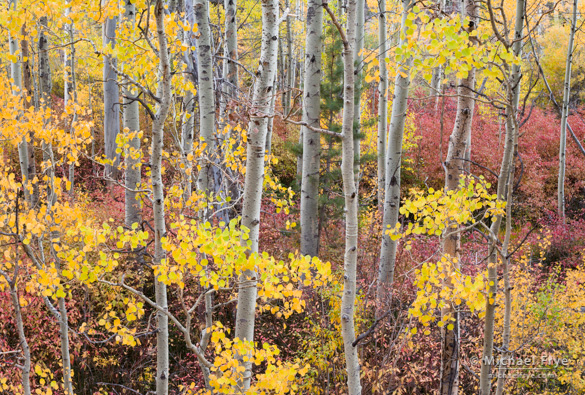
Aspens and dogwoods along Lee Vining Creek
Here’s another image from my recent sojourn to the eastern Sierra, with aspens and dogwoods in Lee Vining Canyon.
Over on the western side of the mountains I had a chance to check on conditions in Yosemite Valley yesterday, and can report that autumn is arriving slowly. I found some nice color across the river from El Capitan, underneath Middle Cathedral Rock, where most of the maples have turned yellow. Some other maples around the valley have also turned, along with a few dogwoods and cottonwoods, but most of the deciduous trees are still green.
It looks like the peak color is still at least a week away, but the good news is that most of the trees seem to be in good shape. The leaves on a few dogwoods have already wilted and turned brown, but these are a small minority. Last year most of the cottonwood leaves wilted before changing color, but this year the cottonwoods look normal—if still mostly green.
(more…)
by Michael Frye | Oct 24, 2012 | Vision and Creativity, Yosemite Photo Conditions
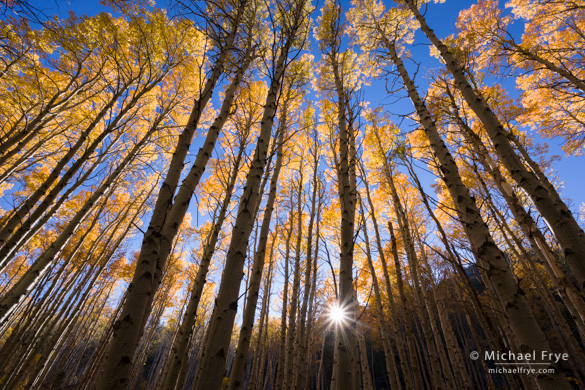
Backlit aspens, Saturday afternoon
Mike Osborne and I just completed our Eastern Sierra Fall Color workshop this past weekend. It was a lot of fun—wonderful people, beautiful weather, and lots of color.
The focus of this workshop was composition and creativity, and it was great to see the participants growing and learning during the class. I saw a lot of beautiful compositions and imaginative ideas on the back of people’s cameras and in the evening image-review sessions.
One of the things we talked about during this class was the creative process. This process varies from one person to another, of course, and can also change depending on the situation and subject. Sometimes—especially with my nighttime work—I plan out every detail in advance. At other times—particularly if I’m in what Mike calls a “target-rich environment,” with interesting subjects and light—then I tend to work quickly, reacting to the changing light and photographing whatever catches my eye at that moment.
The accompanying photographs show a small demonstration of that “reactive” process in an aspen grove on Saturday afternoon. When we first arrived at this spot the trees were in the sun, and the backlit orange leaves against the blue sky were a striking sight. We all tried different compositions—looking up, looking into the sun, using both wide-angle and telephoto lenses. Of my own images, I ended up liking the wide-angle frame at the top of this post the best, with the sun about to dip behind the background ridge.
(more…)
by Michael Frye | Oct 16, 2012 | Yosemite Photo Conditions
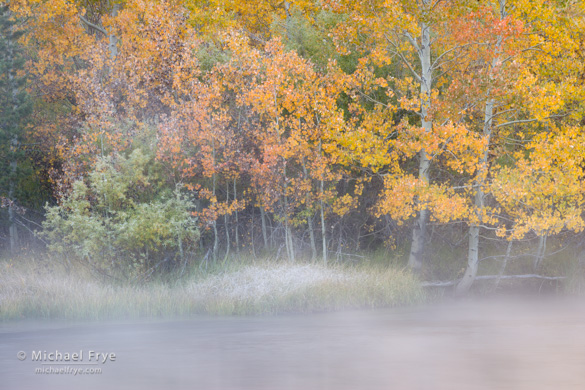
Misty creek with aspens near the June Lake Loop, Sunday morning
Sunday I returned from teaching a four-day private workshop in Yosemite Valley and Lee Vining. As I reported in my last post, the color in Yosemite Valley is slow to arrive. Over on the eastern side of the Sierra some aspens are turning, but most of the groves near Lee Vining are not yet at peak. Here’s a breakdown:
June Lake Loop: About 20% turning, another 40% lime green, the remaining 40% dark green.
Lee Vining Canyon: The same, about 20% turning, 40% lime green, 40% dark green
Lundy Canyon (along the road up to the trailhead): About 30% turning, 50% lime green, 20% dark green. Most of the best color is in the lower part of the canyon.
Conway Summit: About 30% turning, 40% lime green, 30% dark green.
Above Conway Summit: The aspens in the first half mile of the road to Virginia Lakes are a mix of yellow and lime green. About a mile above Conway Summit there’s a colorful patch of orange but scrubby aspens down in a small valley to the right of the road; that grove was at peak Friday. Further up most of the aspens are bare.
(more…)











